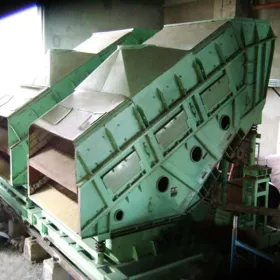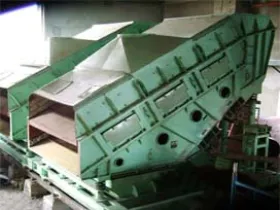
Do you know the types of vibrating screens? Read on for more information.
Inclined screen
The inclined screen is the simplest type of screen, mounted on a frame inclined at an angle between 15° and 30°. The entire screen body oscillates on circular coil springs with the same characteristics, and the material flow is fed by gravity acceleration.
Inclined screens consist of eight basic components, namely side walls, bridges, screen material, exciter, electric motor, motor support, spring and spring supports. The main critical factor of inclined screens is their flawless design. All the parts mentioned here are assembled with nuts and bolts to prevent the screen body from breaking and failing due to welding.
The inclination of the tilting screen is fixed, but the stroke can be adjusted to the desired level. The general working stroke of a tilting screen is between 8 and 12 mm, and the design of tilting screens allows this stroke to be changed by adding or removing additional eccentric weights on the exciter.
Tilt screen exciters are usually driven by an external electric motor that transmits power through a belt and pulley mechanism. Oscillating exciters are not used for tilt screens because of their rigid operating principle. The advantage of the circular vibratory exciter mechanism used in tiltable screens is its simplicity, low maintenance requirements, and economical design.
Tiltable screens are usually equipped with multiple decks so that the material can be classified into 2 to 5 classes. In addition, these screens are usually equipped with an impact zone just before the start of the screen section, which breaks up the material and ensures that the long pieces are deposited horizontally during screening.
Horizontal screen
A horizontal screen is an unconventional design with unique features that distinguish it from other conventional screen types. Its most obvious advantage is its working angle. While conventional screens operate at an angle between 15° and 30°, horizontal screens are placed parallel to the ground or at a slight angle between 0° and 5° degrees.
The stroke of horizontal screens can be adjusted in the range of 14 to 20 mm, although they generally operate with a stroke of 16 to 18 mm and a rotational speed of 750 rpm. The flow velocity of the material in the screening medium varies between 0.2 m/s and 0.25 m/s. The mass throughput depends on the phase angle differences between the eccentric masses.
Horizontal screens are equipped with a triple drive mechanism that produces an elliptical oscillatory motion with the desired stroke and inclination. As mentioned in the previous section on the excitation mechanism, the triple drive mechanism combines the linear and circular vibration modes into one elliptical vibration. In this way, the advantages of both types of vibration are combined in a horizontal screen so that the material is transported horizontally at a speed determined by the linear vibration motion, while the circular vibration characteristic of the elliptical motion prevents sedimentation.
Horizontal screens have brought many advantages to screening operation, although they also have some disadvantages, the most important of which is the complexity of the triple drive mechanism. Although the triple drive mechanisms are designed to be robust enough to withstand all conditions, the maintenance procedures are not short, although the robustness of the design makes frequent maintenance unnecessary.
Dewatering screen
Dewatering screens are designed to remove water from the slurry and reduce the water content of the material. These systems consist of a pair of vibration motors, support for the vibration motor, screen support, and a screen. The screen surface is slightly inclined (between 0° and 5°) to facilitate dewatering, and the operating speed is between 1000 and 1500 RPM.
Unlike screens for dry materials, dewatering screens operate with G-forces greater than 5 g and ensure perfect dewatering. Generally, a range of 5 g and 6 g is used. This condition is necessary for good dewatering.
The counter-rotating vibrators generate a linear vibration that causes the screen body to vibrate with the slurry. The water contained in the slurry is dewatered by the vibration and runs off the bottom of the screen surface as the material is advanced. In this way, a pool of water forms in the valley, while the sand accumulates on the downward sloping surface. The upward slope of the grate, combined with a drainage channel, creates a deep bottom that serves as a filter medium and retains material much finer than the grate openings.
Due to the humid and corrosive environment of the dewatering silo, rubber springs must be used in the support legs to absorb the vibration load of the moving frame, extending the life and maintenance time of the screen.
High-frequency screens
High-frequency screens are designed to provide higher throughput and more efficient classification than conventional screens. High-frequency screens use aggressive vibrations that act directly on the screen, providing the highest capacity on the market for removing fines and cleaning chips, dry sand, and more.
The high frequency and low amplitude provide higher speed material movement without loss of screening efficiency. This combination of high frequency and amplitude is ideal for fine material screening, where coarse particles are lifted higher while finer particles remain closer to the screen, increasing the likelihood of separation with high-frequency screens.
Unlike other types of screens, the vibration motors of high-frequency screens are mounted in each plane rather than in the screen housing. The aggressive vibrations are transmitted directly to the material being screened in the range of 3600 to 5000 rpm, resulting in higher productivity and more efficient screening than conventional screens. Under the influence of the high-frequency vibrations, the depth at the bottom is reduced, allowing stratification and better screening performance.
We are a Vibrating Screen supplier, please feel free to contact us if you need them.





